Solar eclipse of January 25, 1944
| Solar eclipse of January 25, 1944 | |
|---|---|
| Type of eclipse | |
| Nature | Total |
| Gamma | 0.2025 |
| Magnitude | 1.0428 |
| Maximum eclipse | |
| Duration | 249 s (4 min 9 s) |
| Coordinates | 7°36′S 50°12′W / 7.6°S 50.2°W |
| Max. width of band | 146 km (91 mi) |
| Times (UTC) | |
| Greatest eclipse | 15:26:42 |
| References | |
| Saros | 130 (48 of 73) |
| Catalog # (SE5000) | 9384 |
A total solar eclipse occurred at the Moon's descending node of orbit on Tuesday, January 25, 1944,[1] with a magnitude of 1.0428. A solar eclipse occurs when the Moon passes between Earth and the Sun, thereby totally or partly obscuring the image of the Sun for a viewer on Earth. A total solar eclipse occurs when the Moon's apparent diameter is larger than the Sun's, blocking all direct sunlight, turning day into darkness. Totality occurs in a narrow path across Earth's surface, with the partial solar eclipse visible over a surrounding region thousands of kilometres wide. Occurring only about 20 hours before perigee (on January 26, 1944, at 11:30 UTC), the Moon's apparent diameter was larger.[2]
Totality was visible from Peru, Brazil, British Sierra Leone (today's Sierra Leone), and French West Africa (the parts now belonging to Guinea, Mali, Burkina Faso and Niger, including Guinean capital Conakry). A partial eclipse was visible for parts of southern North America, Central America, the Caribbean, South America, Western Europe, West Africa, and Central Africa.
Observations
[edit]The National Astronomical Observatory in Tacubaya, Mexico sent a team to Chiclayo, Peru. The weather was clear during the eclipse, and because totality occurred shortly after sunrise with a relatively low solar zenith angle, the boundary between the corona and the background of the sky was not so obvious. Most images were taken successfully except for one with the long focus camera.[3]
Eclipse details
[edit]Shown below are two tables displaying details about this particular solar eclipse. The first table outlines times at which the moon's penumbra or umbra attains the specific parameter, and the second table describes various other parameters pertaining to this eclipse.[4]
| Event | Time (UTC) |
|---|---|
| First Penumbral External Contact | 1944 January 25 at 12:48:43.4 UTC |
| First Umbral External Contact | 1944 January 25 at 13:44:39.3 UTC |
| First Central Line | 1944 January 25 at 13:45:20.7 UTC |
| First Umbral Internal Contact | 1944 January 25 at 13:46:02.2 UTC |
| First Penumbral Internal Contact | 1944 January 25 at 14:43:56.2 UTC |
| Ecliptic Conjunction | 1944 January 25 at 15:24:37.3 UTC |
| Greatest Duration | 1944 January 25 at 15:25:00.3 UTC |
| Greatest Eclipse | 1944 January 25 at 15:26:42.2 UTC |
| Equatorial Conjunction | 1944 January 25 at 15:29:42.0 UTC |
| Last Penumbral Internal Contact | 1944 January 25 at 16:09:24.1 UTC |
| Last Umbral Internal Contact | 1944 January 25 at 17:07:18.8 UTC |
| Last Central Line | 1944 January 25 at 17:08:01.3 UTC |
| Last Umbral External Contact | 1944 January 25 at 17:08:43.9 UTC |
| Last Penumbral External Contact | 1944 January 25 at 18:04:37.4 UTC |
| Parameter | Value |
|---|---|
| Eclipse Magnitude | 1.04282 |
| Eclipse Obscuration | 1.08747 |
| Gamma | 0.20246 |
| Sun Right Ascension | 20h27m33.6s |
| Sun Declination | -19°07'44.1" |
| Sun Semi-Diameter | 16'14.7" |
| Sun Equatorial Horizontal Parallax | 08.9" |
| Moon Right Ascension | 20h27m26.2s |
| Moon Declination | -18°55'30.7" |
| Moon Semi-Diameter | 16'39.5" |
| Moon Equatorial Horizontal Parallax | 1°01'08.4" |
| ΔT | 26.3 s |
Eclipse season
[edit]This eclipse is part of an eclipse season, a period, roughly every six months, when eclipses occur. Only two (or occasionally three) eclipse seasons occur each year, and each season lasts about 35 days and repeats just short of six months (173 days) later; thus two full eclipse seasons always occur each year. Either two or three eclipses happen each eclipse season. In the sequence below, each eclipse is separated by a fortnight.
| January 25 Descending node (new moon) |
February 9 Ascending node (full moon) |
|---|---|
 |
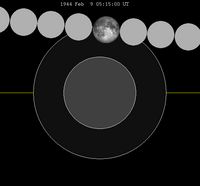
|
| Total solar eclipse Solar Saros 130 |
Penumbral lunar eclipse Lunar Saros 142 |
Related eclipses
[edit]Eclipses in 1944
[edit]- A total solar eclipse on January 25.
- A penumbral lunar eclipse on February 9.
- A penumbral lunar eclipse on July 6.
- An annular solar eclipse on July 20.
- A penumbral lunar eclipse on August 4.
- A penumbral lunar eclipse on December 29.
Metonic
[edit]- Preceded by: Solar eclipse of April 7, 1940
- Followed by: Solar eclipse of November 12, 1947
Tzolkinex
[edit]- Preceded by: Solar eclipse of December 13, 1936
- Followed by: Solar eclipse of March 7, 1951
Half-Saros
[edit]- Preceded by: Lunar eclipse of January 19, 1935
- Followed by: Lunar eclipse of January 29, 1953
Tritos
[edit]- Preceded by: Solar eclipse of February 24, 1933
- Followed by: Solar eclipse of December 25, 1954
Solar Saros 130
[edit]- Preceded by: Solar eclipse of January 14, 1926
- Followed by: Solar eclipse of February 5, 1962
Inex
[edit]- Preceded by: Solar eclipse of February 14, 1915
- Followed by: Solar eclipse of January 4, 1973
Triad
[edit]- Preceded by: Solar eclipse of March 25, 1857
- Followed by: Solar eclipse of November 25, 2030
Solar eclipses of 1942–1946
[edit]This eclipse is a member of a semester series. An eclipse in a semester series of solar eclipses repeats approximately every 177 days and 4 hours (a semester) at alternating nodes of the Moon's orbit.[5]
The partial solar eclipses on March 16, 1942 and September 10, 1942 occur in the previous lunar year eclipse set, and the partial solar eclipses on May 30, 1946 and November 23, 1946 occur in the next lunar year eclipse set.
| Solar eclipse series sets from 1942 to 1946 | ||||||
|---|---|---|---|---|---|---|
| Ascending node | Descending node | |||||
| Saros | Map | Gamma | Saros | Map | Gamma | |
| 115 | August 12, 1942 Partial |
−1.5244 | 120 | February 4, 1943 Total |
0.8734 | |
| 125 | August 1, 1943 Annular |
−0.8041 | 130 | January 25, 1944 Total |
0.2025 | |
| 135 | July 20, 1944 Annular |
−0.0314 | 140 | January 14, 1945 Annular |
−0.4937 | |
| 145 | July 9, 1945 Total |
0.7356 | 150 | January 3, 1946 Partial |
−1.2392 | |
| 155 | June 29, 1946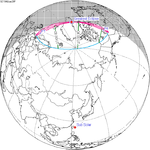 Partial |
1.4361 | ||||
Saros 130
[edit]This eclipse is a part of Saros series 130, repeating every 18 years, 11 days, and containing 73 events. The series started with a partial solar eclipse on August 20, 1096. It contains total eclipses from April 5, 1475 through July 18, 2232. There are no annular or hybrid eclipses in this set. The series ends at member 73 as a partial eclipse on October 25, 2394. Its eclipses are tabulated in three columns; every third eclipse in the same column is one exeligmos apart, so they all cast shadows over approximately the same parts of the Earth.
The longest duration of totality was produced by member 30 at 6 minutes, 41 seconds on July 11, 1619. All eclipses in this series occur at the Moon’s descending node of orbit.[6]
| Series members 41–62 occur between 1801 and 2200: | ||
|---|---|---|
| 41 | 42 | 43 |
 November 9, 1817 |
 November 20, 1835 |
 November 30, 1853 |
| 44 | 45 | 46 |
 December 12, 1871 |
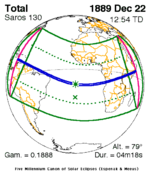 December 22, 1889 |
 January 3, 1908 |
| 47 | 48 | 49 |
 January 14, 1926 |
 January 25, 1944 |
 February 5, 1962 |
| 50 | 51 | 52 |
 February 16, 1980 |
 February 26, 1998 |
 March 9, 2016 |
| 53 | 54 | 55 |
 March 20, 2034 |
 March 30, 2052 |
 April 11, 2070 |
| 56 | 57 | 58 |
 April 21, 2088 |
 May 3, 2106 |
 May 14, 2124 |
| 59 | 60 | 61 |
 May 25, 2142 |
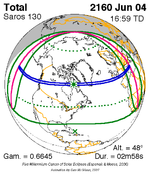 June 4, 2160 |
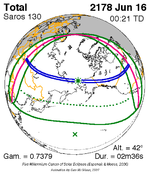 June 16, 2178 |
| 62 | ||
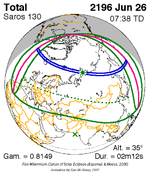 June 26, 2196 | ||
Metonic series
[edit]The metonic series repeats eclipses every 19 years (6939.69 days), lasting about 5 cycles. Eclipses occur in nearly the same calendar date. In addition, the octon subseries repeats 1/5 of that or every 3.8 years (1387.94 days). All eclipses in this table occur at the Moon's descending node.
| 22 eclipse events between April 8, 1902 and August 31, 1989 | ||||
|---|---|---|---|---|
| April 7–8 | January 24–25 | November 12 | August 31–September 1 | June 19–20 |
| 108 | 110 | 112 | 114 | 116 |
 April 8, 1902 |
 August 31, 1913 |
 June 19, 1917 | ||
| 118 | 120 | 122 | 124 | 126 |
 April 8, 1921 |
 January 24, 1925 |
 November 12, 1928 |
 August 31, 1932 |
 June 19, 1936 |
| 128 | 130 | 132 | 134 | 136 |
 April 7, 1940 |
 January 25, 1944 |
 November 12, 1947 |
 September 1, 1951 |
 June 20, 1955 |
| 138 | 140 | 142 | 144 | 146 |
 April 8, 1959 |
 January 25, 1963 |
 November 12, 1966 |
 August 31, 1970 |
 June 20, 1974 |
| 148 | 150 | 152 | 154 | |
 April 7, 1978 |
 January 25, 1982 |
 November 12, 1985 |
 August 31, 1989 | |
Tritos series
[edit]This eclipse is a part of a tritos cycle, repeating at alternating nodes every 135 synodic months (≈ 3986.63 days, or 11 years minus 1 month). Their appearance and longitude are irregular due to a lack of synchronization with the anomalistic month (period of perigee), but groupings of 3 tritos cycles (≈ 33 years minus 3 months) come close (≈ 434.044 anomalistic months), so eclipses are similar in these groupings.
| Series members between 1801 and 2200 | ||||
|---|---|---|---|---|
 March 4, 1802 (Saros 117) |
 February 1, 1813 (Saros 118) |
 January 1, 1824 (Saros 119) |
 November 30, 1834 (Saros 120) |
 October 30, 1845 (Saros 121) |
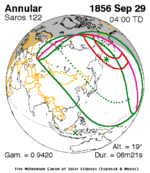 September 29, 1856 (Saros 122) |
 August 29, 1867 (Saros 123) |
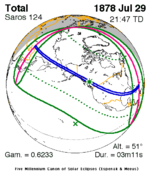 July 29, 1878 (Saros 124) |
 June 28, 1889 (Saros 125) |
 May 28, 1900 (Saros 126) |
 April 28, 1911 (Saros 127) |
 March 28, 1922 (Saros 128) |
 February 24, 1933 (Saros 129) |
 January 25, 1944 (Saros 130) |
 December 25, 1954 (Saros 131) |
 November 23, 1965 (Saros 132) |
 October 23, 1976 (Saros 133) |
 September 23, 1987 (Saros 134) |
 August 22, 1998 (Saros 135) |
 July 22, 2009 (Saros 136) |
 June 21, 2020 (Saros 137) |
 May 21, 2031 (Saros 138) |
 April 20, 2042 (Saros 139) |
 March 20, 2053 (Saros 140) |
 February 17, 2064 (Saros 141) |
 January 16, 2075 (Saros 142) |
 December 16, 2085 (Saros 143) |
 November 15, 2096 (Saros 144) |
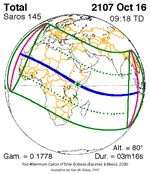 October 16, 2107 (Saros 145) |
 September 15, 2118 (Saros 146) |
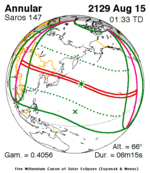 August 15, 2129 (Saros 147) |
 July 14, 2140 (Saros 148) |
 June 14, 2151 (Saros 149) |
 May 14, 2162 (Saros 150) |
 April 12, 2173 (Saros 151) |
 March 12, 2184 (Saros 152) |
 February 10, 2195 (Saros 153) | |||
Inex series
[edit]This eclipse is a part of the long period inex cycle, repeating at alternating nodes, every 358 synodic months (≈ 10,571.95 days, or 29 years minus 20 days). Their appearance and longitude are irregular due to a lack of synchronization with the anomalistic month (period of perigee). However, groupings of 3 inex cycles (≈ 87 years minus 2 months) comes close (≈ 1,151.02 anomalistic months), so eclipses are similar in these groupings.
| Series members between 1801 and 2200 | ||
|---|---|---|
 April 14, 1828 (Saros 126) |
 March 25, 1857 (Saros 127) |
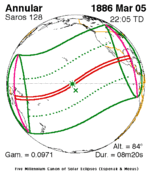 March 5, 1886 (Saros 128) |
 February 14, 1915 (Saros 129) |
 January 25, 1944 (Saros 130) |
 January 4, 1973 (Saros 131) |
 December 14, 2001 (Saros 132) |
 November 25, 2030 (Saros 133) |
 November 5, 2059 (Saros 134) |
 October 14, 2088 (Saros 135) |
 September 26, 2117 (Saros 136) |
 September 6, 2146 (Saros 137) |
 August 16, 2175 (Saros 138) |
||
Notes
[edit]- ^ "January 25, 1944 Total Solar Eclipse". timeanddate. Retrieved 4 August 2024.
- ^ "Moon Distances for London, United Kingdom, England". timeanddate. Retrieved 4 August 2024.
- ^ Harlow Shapley (1944). "Total Solar Eclipse of January 25, 1944". Popular Astronomy. 52: 107. Archived from the original on 27 August 2019.
- ^ "Total Solar Eclipse of 1944 Jan 25". EclipseWise.com. Retrieved 4 August 2024.
- ^ van Gent, R.H. "Solar- and Lunar-Eclipse Predictions from Antiquity to the Present". A Catalogue of Eclipse Cycles. Utrecht University. Retrieved 6 October 2018.
- ^ "NASA - Catalog of Solar Eclipses of Saros 130". eclipse.gsfc.nasa.gov.
References
[edit]- Earth visibility chart and eclipse statistics Eclipse Predictions by Fred Espenak, NASA/GSFC
Text is available under the CC BY-SA 4.0 license; additional terms may apply.
Images, videos and audio are available under their respective licenses.




